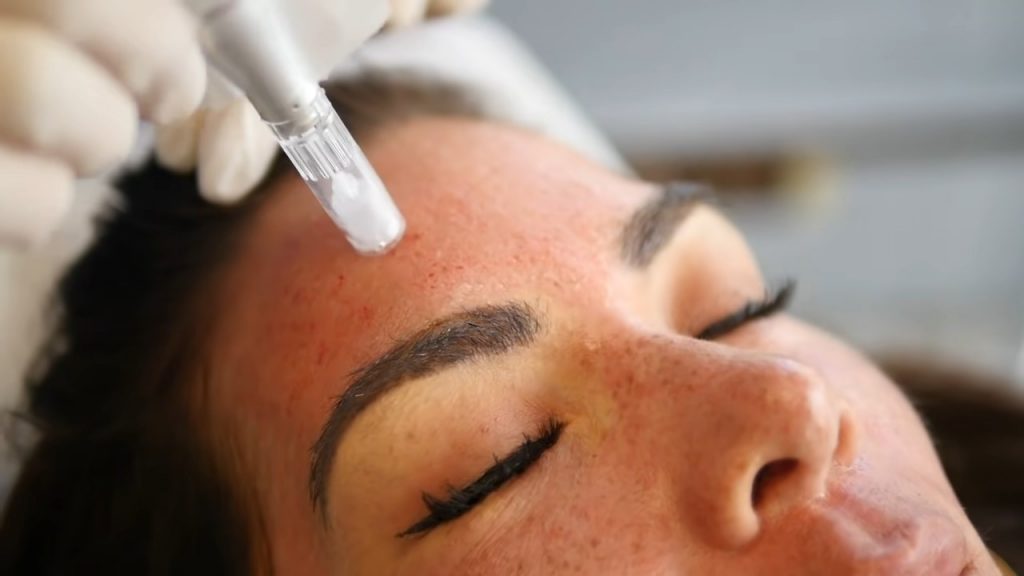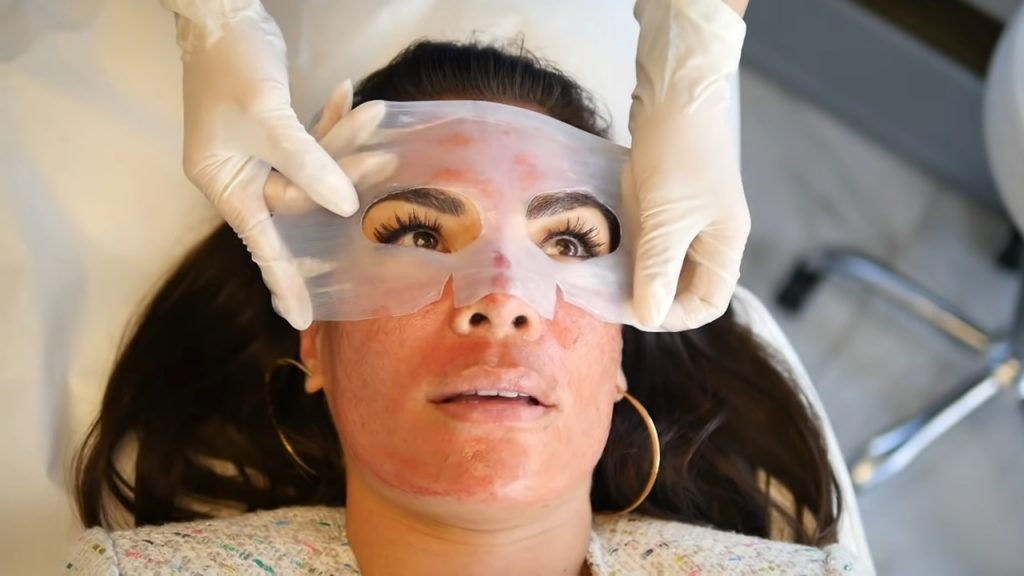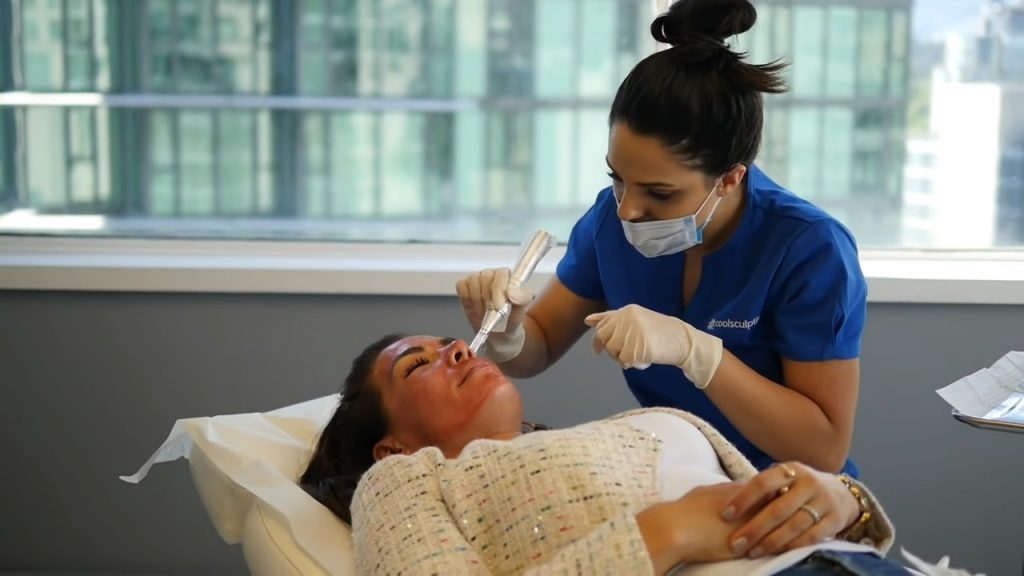There are many different methods for treating psoriasis, each with varying levels of effectiveness. However, the ultimate goal is always the same – to relieve the symptoms of psoriasis in patients.
One such method is microneedling, which is designed to improve the overall health of the skin and prevent the development of other skin issues over time.
If you’re interested in learning more about how microneedling can help manage your psoriasis symptoms, keep reading.

What Is Microneedling?
Microneedling is a cosmetic skin care procedure designed to improve the overall health of your skin. During the procedure, sterilized needles are used to prick the skin, which triggers the body’s production of elastin and collagen. These two proteins are responsible for healing the skin and giving it a more youthful appearance.
Also known as collagen induction therapy, some people choose to perform microneedling at home using a derma roller. However, this approach can come with risks.
For individuals with psoriasis, microneedling can be especially beneficial, as the disease tends to accelerate the aging process. Microneedling has the potential to prevent and delay the rapid aging caused by psoriasis symptoms.
Benefits of Microneedling for Psoriasis
Microneedling is a cosmetic skin care procedure that can offer several benefits to individuals with psoriasis. This procedure can be an effective treatment option to relieve the symptoms of psoriasis, such as redness, inflammation, and flaking. Here are some of the benefits of microneedling for psoriasis:
- Stimulates collagen production: Microneedling stimulates the production of collagen, a protein that is essential for skin health. Collagen helps to restore and regenerate damaged skin, reducing the appearance of psoriasis symptoms.
- Increases skin absorption: Microneedling creates tiny channels in the skin, which allows topical medications to penetrate deeper into the skin. This can increase the effectiveness of topical psoriasis medications and reduce the frequency of application.
- Reduces inflammation: Microneedling can help reduce inflammation in the skin, which is a common symptom of psoriasis. By reducing inflammation, microneedling can provide relief from redness, itchiness, and discomfort.
- Improves skin texture: Microneedling can improve the texture of the skin, making it smoother and more even. This can help to reduce the appearance of psoriasis symptoms and improve the overall appearance of the skin.
- Non-invasive and safe: Microneedling is a non-invasive and safe procedure that can be performed in a dermatologist’s office or at home with a derma roller. This makes it a convenient treatment option for individuals with psoriasis who may be hesitant to undergo more invasive procedures.
Overall, microneedling is a promising treatment option for individuals with psoriasis, as it can provide several benefits to improve the health and appearance of their skin.
Other Advantages of Microneedling
Microneedling can offer several benefits for the skin, including reducing the effects of sun damage, decreasing the aging process, treating scars, serving as a better alternative to laser or chemical peels, and improving the absorption of topical treatments.
One of the best benefits of microneedling is its ability to treat sun-damaged areas. It can effectively reduce hyperpigmentation and age spots, which is important for individuals with psoriasis who may be at higher risk for sun damage due to their skin’s uneven spots.
Microneedling can also decrease the aging process by stimulating the production of elastin and collagen, which helps to improve the skin structure and fight against the sagging effect that may occur after healing from psoriasis.
Additionally, microneedling can be a great way to treat scars caused by psoriasis. It can regenerate dead cells and minimize the visual aspects of scars, making it a better alternative to laser or chemical peels, which can be too aggressive for some individuals.
Furthermore, microneedling improves the absorption of topical treatments by allowing the skin to better absorb any treatment applied to it during the recovery process. This can provide a significant boost to the skin’s health and overall appearance.
Microneedling can be an effective treatment option for individuals with psoriasis to improve their skin’s health and appearance. It’s important to consult with a dermatologist to determine if microneedling is a suitable treatment option.

How to treat Psoriasis with Microneedling
Here’s how to treat psoriasis with microneedling:
- Consult with a Dermatologist: Before starting any treatment, it is important to consult with a dermatologist to determine if microneedling is a suitable treatment option for your psoriasis.
- Prepare the Skin: Cleanse the skin and make sure it is free from any creams, oils, or makeup.
- Use a Microneedling Device: Choose a microneedling device that is specifically designed for the treatment of psoriasis. A derma roller with needles of 0.5 to 1.5 millimeters is a good option. Make sure the device is sterilized before use.
- Microneedling Process: Roll the device over the affected area in multiple directions, gently pricking the skin with the needles. Be careful not to apply too much pressure as it may cause injury to the skin.
- Apply Topical Treatments: As soon as you are done with the microneedling process, apply your preferred topical treatment, such as vitamin C serum, to help the skin recover faster and improve the results.
- Recovery: After microneedling, the skin may be red and slightly swollen, but this should subside within 24-72 hours. During this time, avoid any sun exposure and apply sunscreen when going outside.
- Repeat the Process: Depending on the severity of psoriasis, it may take several sessions to see results. A dermatologist will be able to advise on the number of sessions needed.
It is important to note that microneedling may not be suitable for all individuals with psoriasis, especially those with severe or active flare-ups.
How to treat Psoriasis using a Microneedling Device
Microneedling can be a beneficial treatment option for psoriasis patients. It helps in the rejuvenation of skin cells and reduces the visibility of scars caused by psoriasis. Here are some steps on how to treat psoriasis using a microneedling device:
- Choose a microneedling device – First, you need to choose a microneedling device. Make sure to select a device with a needle length of 0.5mm to 1.5mm. This length is effective for psoriasis treatment.
- Cleanse your skin – Before starting the treatment, make sure to cleanse your skin properly. Use a gentle cleanser to remove all the impurities from your skin.
- Apply numbing cream – Apply numbing cream to your skin to minimize discomfort during the microneedling treatment. Wait for 20-30 minutes for the cream to take effect.
- Start microneedling – Start the microneedling treatment by rolling the device over the affected area of your skin. Roll the device vertically, horizontally, and diagonally in a criss-cross pattern. Make sure to apply even pressure throughout the process.
- Apply topical treatment – After the microneedling treatment, you can apply your favorite topical treatments such as creams or serums. This is the best time to apply the treatment as the skin is in a recovery process and will absorb the treatment better.
- Clean the device – After using the microneedling device, make sure to clean it properly. Use warm water and soap to clean the needles and then disinfect them using alcohol.
- Follow up – Repeat the treatment every 4-6 weeks. It is essential to follow up and stay consistent with the treatment for better results.
It is important to note that microneedling can cause some redness, swelling, and discomfort, but these symptoms should subside within a few days.
Pro Tips When using a Microneedling Device
If you are using a microneedling device, here are some pro tips to keep in mind:
- Cleanse your skin thoroughly with a gentle cleanser before using the device. This will help remove any dirt, oil, or makeup from your skin and prepare it for the treatment.
- Apply a treatment serum to your skin before using the device. This will help the needles glide smoothly over your skin and maximize the benefits of the treatment.
- Roll the device over your skin in a criss-cross pattern, making sure to cover all the areas you want to treat. For example, you can roll 2 to 3 times horizontally, diagonally, and vertically on your face, including your forehead, lips/chin, cheeks, and neck.
- Apply another layer of the treatment serum after using the device, and finish with a moisturizer of your choice. This will help soothe and hydrate your skin after the treatment.
- To minimize any inflammation or redness that may occur after the treatment, you can use an ice roller or a cold compress to cool down your skin.
- Remember to avoid using the microneedling device on any active psoriasis spots or flaky/wounded areas, as this can lead to infection and discomfort.
By following these tips, you can effectively use a microneedling device to improve the appearance and health of your skin.

Side Effects of Microneedling for Psoriasis
Microneedling is a minimally invasive cosmetic procedure that is generally safe and effective for treating various skin conditions including psoriasis. However, as with any medical procedure, there are some potential side effects that you should be aware of before undergoing microneedling for psoriasis.
- Skin irritation: After microneedling, your skin may become red, swollen, and tender. This is a normal reaction that typically resolves within a few days. However, in rare cases, you may experience prolonged skin irritation or even an allergic reaction to the treatment.
- Infection: If you use an unsterilized microneedling device or apply it to a psoriasis spot that is currently infected, you may develop an infection. This can lead to the further spread of the infection throughout your skin, so it’s important to follow proper sterilization protocols and avoid using the device on any active psoriasis spots.
- Hyperpigmentation: In some cases, microneedling can cause hyperpigmentation, which is a darkening of the skin. This is more common in people with darker skin tones, but it can occur in anyone. It is usually a temporary side effect that fades over time.
- Scarring: While rare, microneedling can cause scarring, particularly if the procedure is not done correctly or if the patient has a pre-existing condition that increases the risk of scarring. To minimize the risk of scarring, it’s important to use a high-quality microneedling device and follow the proper technique.
- Pain: Microneedling can be a painful procedure, particularly if you have active psoriasis spots or if you have sensitive skin. You can minimize the pain by using a numbing cream or gel before the procedure and avoiding any active psoriasis spots.
The side effects of microneedling for psoriasis are generally mild and temporary. With proper technique and aftercare, most people can safely undergo this procedure to improve the appearance and health of their skin.
Pricing Disadvantage of Microneedling
Another potential disadvantage of microneedling is its cost. Compared to other treatments, a session of microneedling can be relatively expensive, with prices ranging from $200 to $800. Additionally, it is not typically covered by insurance, which can make it a less accessible option for some individuals.
Common Microneedling Mistakes That Can Potentially Cause Psoriasis
- Failing to sanitize your microneedling tool before use, can lead to infection and potentially trigger psoriasis.
- Overusing the microneedling device, which can damage the skin barrier and worsen psoriasis symptoms.
- Not replacing the microneedling device often enough, as dull needles can cause skin damage and potentially cause psoriasis flare-ups.
- Using the wrong needle size for your skin type, can cause skin irritation, and inflammation, and potentially trigger psoriasis.
- Inconsistent use of microneedling, may not provide the desired results and potentially worsen psoriasis.
- Microneedling too aggressively or applying too much pressure, can damage the skin and lead to psoriasis flare-ups.
- Failing to use sunscreen after microneedling, can cause sun damage and potentially trigger psoriasis.
- Applying irritating skincare products such as retinol, BHA, and AHA after microneedling, can cause skin irritation and potentially worsen psoriasis.
- Using low-quality derma rollers, which can cause skin damage and potentially trigger psoriasis.
- Microneedling over areas with skin infections, active acne, active psoriasis, or sores, can lead to further infection and potentially worsen psoriasis symptoms.
FAQs
Can Microneedling Make Psoriasis Worse?
Microneedling with psoriasis carries a minor risk of the Koebner phenomenon, but the benefits outweigh the risks.
Can You Damage Your Skin With Microneedling?
Improper use of microneedling can cause significant skin damage, highlighting the importance of proper technique and caution during the procedure.
Does Microneedling Make You Age Faster?
Microneedling does not make you age faster. It stimulates cell regeneration, promoting new cell growth rather than causing damage.
Can Microneedling Cause Scarring?
Microneedling can cause scarring if done incorrectly, so it’s important to follow the correct procedure and use the appropriate tools to avoid this risk.
How Many Times a Year Can You Do Microneedling?
How often can you do microneedling? It’s recommended to limit the frequency of microneedling to 2-3 treatments per year to avoid potential damage to the skin.